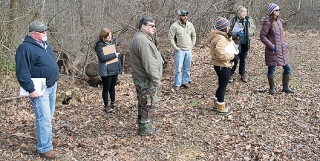Knauss legislative fellowships in Congress help build careers — and they're fun and educational. See our video and fact sheet for details.
Watershed Steward Trainees Scout for Stormwater Problems and Solutions
This is the second of three posts about a group of Maryland residents who were admitted to the 2015-2016 Cecil County Watershed Stewards Academy. Read the previous post.
On a chilly winter morning in Elkton, Maryland, Jennifer Dindinger stands at the edge of a puddle, about a yard wide. The muddy snow meltwater pools on an asphalt exercise path that runs between the rear parking lot of the Cecil County Administration Building and the grassy expanse behind the facility. The puddle feeds on rivulets of snowmelt that meander down the parking lot’s gentle slope. It is a minor obstacle to pedestrians this morning, but during heavy rainstorms, this dip in the walkway can become a sodden streamlet.
To Dindinger, a watershed restoration specialist with Maryland Sea Grant Extension, the puddle is a teachable moment — and potentially an opportunity to contribute in a small way to reducing stormwater pollution of the Chesapeake Bay.
She is surrounded by participants in the Cecil County Watershed Stewards Academy, a group of volunteers learning how to help clean up the Bay. Seizing the teachable moment, Dindinger points to the puddle and asks, “Where is the water coming from? How does it flow? Where does your investigation take you?”
Once they understand that, the stewards can start to consider remedies for the problematic puddle. One option they discuss is to remove the flooded pavement on the walkway and replace it with a shallow gravel trench, which would convey the runoff towards the grassy area behind the administration building or possibly to a small rain garden. To keep the walkway usable, a low wooden bridge could cross the gap.
Dindinger is co-leading the field trip with Marshall McSorley, an inspector with the Sediment and Stormwater Branch of the Cecil County Department of Public Works. McSorley also coordinates the county’s Watershed Stewards Academy. The Cecil academy is the first one in the upper Eastern Shore of the Chesapeake Bay. McSorley scouted all the field trip sites and brainstormed potential solutions that might work at the various locations.
Watershed steward academies, pioneered by Anne Arundel County in 2008, train volunteers to lead efforts in their communities to manage stormwater runoff better. Ultimately, every piddly puddle and trickle of rainwater draining off myriad parking lots, paved streets, and roofs contributes to the sediment and nutrient pollutants that flow into the 64,000-square-mile land area that drains into the Bay. Academy training lasts more than a year, with up to 60 hours in classes as well as field trips, a group project, and individual “capstone” projects in the stewards’ own communities.
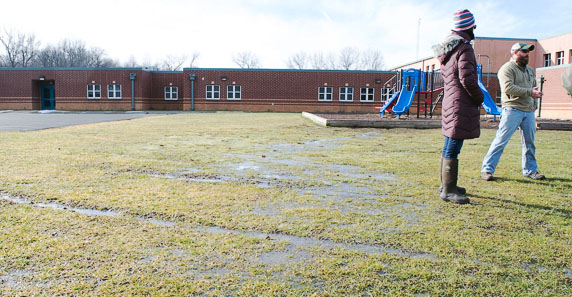 |
|
At Holly Hall Elementary School, rainwater flows off the building’s flat roof into downspouts and onto a lawn. In low spots, rainwater tends to puddle. Installing rain barrels and a rain gardens at some of the downspouts could help — and also teach students about green solutions for stormwater pollution. Photo: Daniel Pendick |
Today’s field trip would include four locations in the Elkton area, counting the administration parking lot. The stewards’ mission: spot stormwater problems and brainstorm ideas for a group project to install a small-scale best management practice (BMP), like a rain garden. At every stop, McSorley’s challenge to the trainees was simple: Where does the water cause problems and what can be done about it?
Sometimes the answer is installing a small-scale BMP to slow down and soak up polluted runoff before it can flow into streams and reach the Bay. The hope: that the combined efforts of a statewide cadre of Master Watershed Stewards will make a difference in the health of the Bay. The program has already graduated more than 300 stewards.
Each site we visited on the field trip presented different stormwater management challenges and opportunities. First stop: Holly Hall Elementary School in Elkton. The sprawling one-story school lies on acres of mostly flat turf. Rainwater runoff from the roof drains through downspouts right onto the grass. It’s near a stream that feeds Big Elk Creek, which empties into the Elk River — less than a mile west of the school and one of the Chesapeake’s tributaries.
The second stop on the tour, the Fair Hill State Natural Resources Management Area, has a more rolling topography, with steep inclines and plenty of low spots for runoff from heavy rains to cause erosion.
.jpg) |
|
Watershed steward trainees examine an overflow parking area that has started to develop a problem with erosion. Field trip co-leader Marshall McSorley (second from left) suggests that reducing the amount of runoff coming from higher ground would help alleviate the problem. Photo: Daniel Pendick |
At the third stop, Elk Neck State Park, two large parking lots near a public beach channel stormwater into the Bay — through buried stormwater drainage pipes and highly eroded gullies at the edges of the parking areas.
By the end of their field-trip day, the group had settled on a site and a management practice for their group project — the Fair Hill Natural Resources Management Area. There they would build an extensive new rain garden to capture stormwater from a large, metal-roofed activity center. (A future post will show the process of building that garden on a long, hot day in June.)
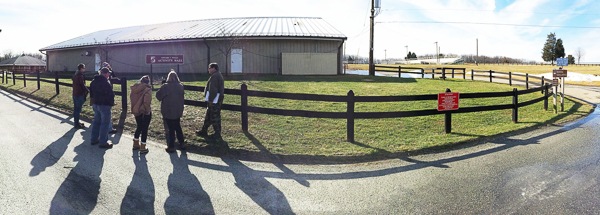 |
| Watershed steward trainees discuss how stormwater flows off the broad metal roof of the Edward L. Walls Activity Hall and onto a wide grassy area. Runoff not absorbed by the turf flows onto the pavement. Soaking up more of the runoff in this grassy area could reduce erosion in lower-lying areas nearby. The class eventually built its group project, a rain garden, at this location. Photo: Daniel Pendick |
Academy participant Janine Antoshak, a clerk with the Town of Charlestown, Maryland, told me that the field trip completely changed the way she looks at parking lots. “It got me thinking about what a parking lot does with stormwater runoff,” Antoshak explains, “how it changes where the water goes, and how it doesn’t have time to get filtered as it quickly runs across a paved surface. I don’t think people really think about that very much.”
Driving home after the field trip, I, too, found myself looking at the landscape with different eyes. Through my new “stormwater goggles,” I spotted artificial ponds and marshes that had been installed on the highway median of I-95 and nestled within the figure-eights of highway interchanges. These green solutions sustainably collect runoff and trap pollutants. And they are the same types of small-scale “practices” that Master Watershed Stewards are trained to plan and build in their communities.
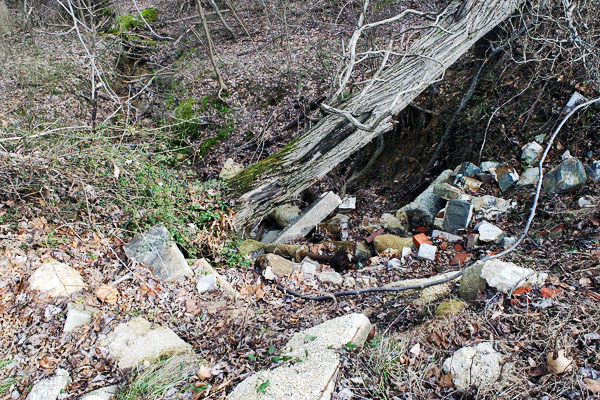 |
| Runoff from a visitor parking lot at Elk Neck State Park gushes into gullies that carry sediment and other pollutants into the Bay. Photo: Daniel Pendick |
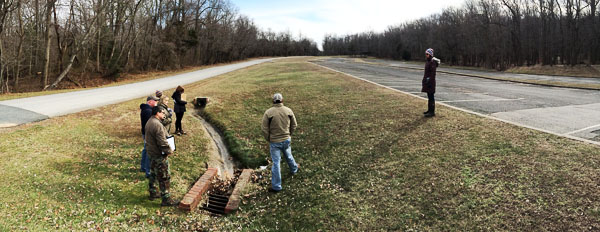 |
| At this sloping parking area at Elk Neck State Park, stormwater pours into drains and buried pipes that empty into the Bay. If the grassy median were planted with meadow grass, wildflowers, or a rain garden, it would soak up and slow down a portion of the runoff before it reached the drain. Photo: Daniel Pendick |
Photo, top left: Participants in the Cecil County Watershed Stewards Academy pause during a field trip to assess how stormwater runoff is likely to drain from a large parking lot at Elk Neck State Park in Maryland. Pictured from left to right are trainees Randy Pritchett, Janine Antoshak, and John Gonzalez; field trip co-leader Marshall McSorley; trainees Jordane Wiseman and Donna Winterling; and trip co-leader Jennifer Dindinger. Photo: Daniel Pendick
About Maryland’s Watershed Stewards Academy Program
Read more about the Watershed Stewards Academies here. There are now five:
- Cecil County Watershed Stewards Academy
- Anne Arundel Watershed Stewards Academy
- Howard County Watershed Stewards Academy
- National Capital Region Watershed Stewards Academy
- St. Mary’s County Watershed Stewards Academy
Around Maryland, the watershed steward academies are sponsored, funded, and taught by a variety of organizations and individuals. The details of the curricula vary, but all meet minimum standards to qualify as a Master Watershed Steward. Besides helping to start new WSAs and teach the courses, watershed specialists with Maryland Sea Grant Extension help organizers apply for grants from various sources, including the Chesapeake Bay Trust and individual and corporate donors, to fund the programs.
Cecil WSA contact information:
Eric Helm Buehl
Watershed Restoration Specialist
University of Maryland Sea Grant Extension
ebuehl@umd.edu
Jennifer Dindinger
Watershed Restoration Specialist
University of Maryland Sea Grant Extension
jdinding@umd.edu
Marshall McSorley
Cecil County WSA Coordinator
mmcsorley@ccgov.org
See all posts from the On the Bay blog
